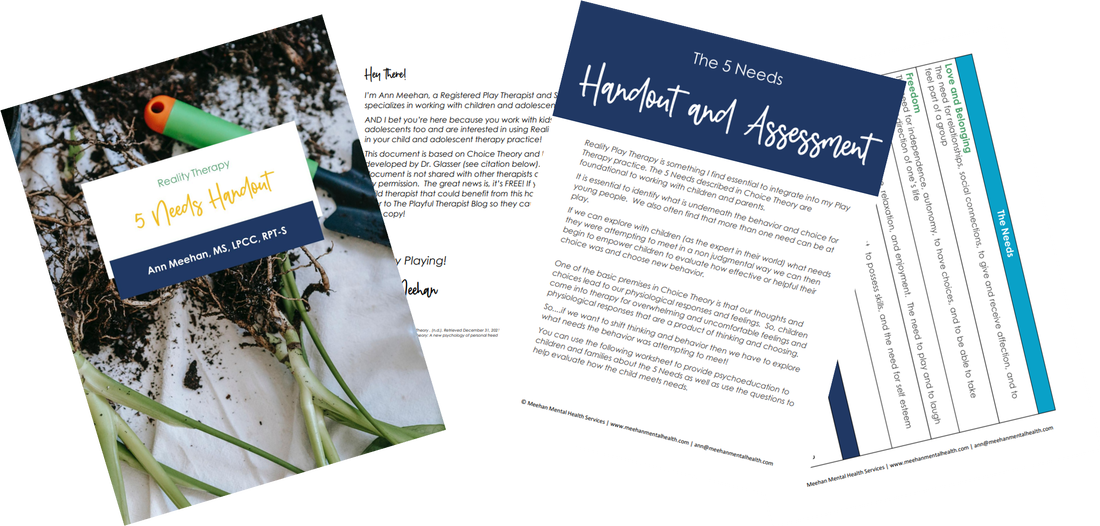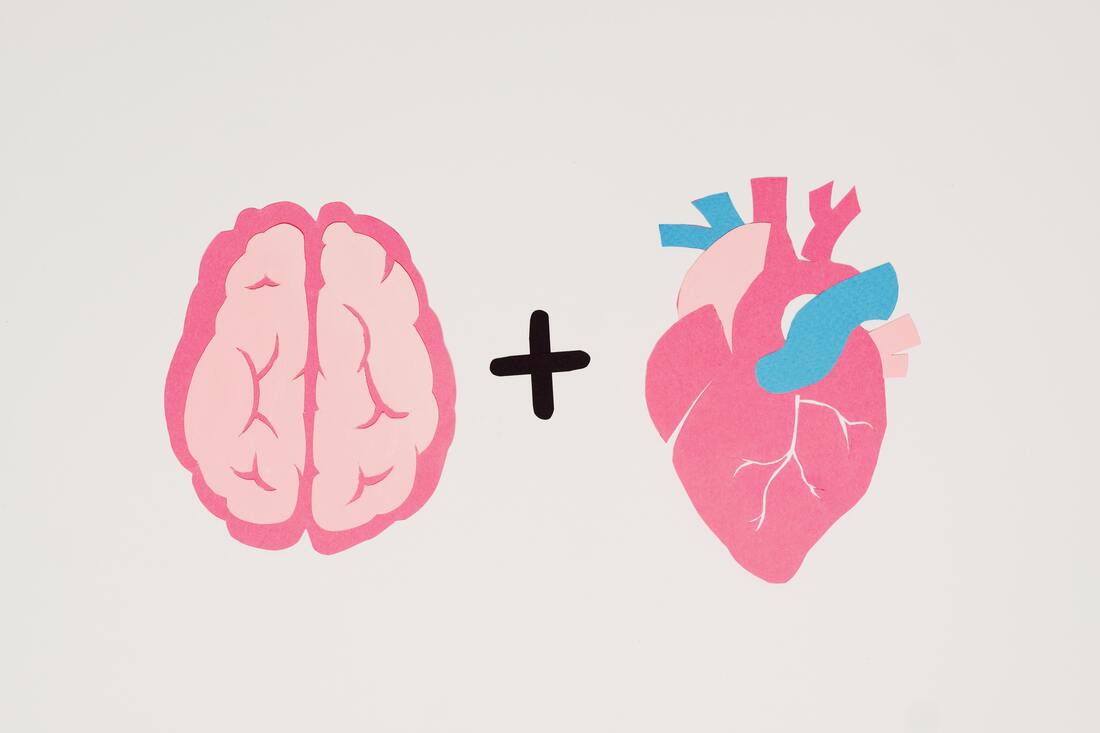|
What if you went to fix a leak in your sink and you only had one tool - a hammer. How effective would that be? Well I know literally nothing about fixing sinks, however I am going to go out on a limb and say… not very effective.
Okay - so bear with me here. I believe that most therapists are prescriptive in nature - meaning you do not have one theory that you use with every single client that walks through your door. You might have your favorites, but each therapist has a unique recipe for how they show up in the Playroom or therapy office. For me my main theories and modalities are Cognitive Behavioral Therapy (including Cognitive Behavioral Play Therapy, Reality Therapy, and DBT Skills), Person Centered Therapy (including Child Centered Play Therapy), and Eye Movement Desensitization and Reprocessing. When I carry out these theories in the Playroom and therapy office I am informed by Polyvagal Theory, Attachment Theory, and Synergetic Play Therapy. AND I don’t believe that every client or every diagnosis should have the same course of therapy because each client is an individual with their own set of experiences, symptom profile, and genetics. So if you are a thinking of adding Reality Play Therapy into your Play Therapy practice (check out more HERE, HERE, and HERE) I wanted to let you know the top 3 reasons I have found it to be so foundational in my practice: It gives children control. In a world where children are often controlled by systems such as household rules, a specific time school starts, classes they need to take, food that is being put on the table, they can often lose hope. Children can develop a worldview that the child’s reality is a product of the world around them rather than controlled within themselves. I think we have all had a client who blames things such as their poor grades on factors outside themselves such as a teacher’s style, parent's high expectations, etc. rather than the choice of not to study, failure to turn in assignments or ask for help or support. I want to be mindful that a subject such as difficulties with grades can be due to learning disabilities and racial and ethnic inequality in education. For these children partnering with parents is essential to alter systems and increase ability for choice. This may mean parents advocating for children within systems to provide them more support and choices to meet academic needs, such as an IEP or 504 plan or systemic changes in the school system. In all of this, children do have choice and giving them the ability to recognize their choice and power, evaluate the effectiveness of their choices and behaviors, and identify alternative ways to meet their needs that are helpful to both themselves and those around them is a beautiful thing to see! It increases parent compassion and effectiveness Oftentimes parents have a misguided view of behavior. When using Reality Therapy in working with children it is essential to involve parents and provide psychoeducation about Choice Theory and Reality Therapy. When I think back on my therapy week, I find myself discussing the 5 basic needs as a motivation for choice and behavior nearly every day in my practice. Once parents can shift their thinking about behavior to a way for their child to meet their needs then parents can begin to evaluate the ways they are supporting their child with meeting their needs in ways that are helpful. This includes conversations such as how to parenting rules and structures in the home promote or restrict meeting needs. What needs does the family support the most? Which are the most difficult? How can the family shift family behavior to meet the needs of the child? It’s effective and engaging I have found using Reality Play Therapy in my practice with young people significantly increases engagement. As a therapist when you come from the lens that all behavior is purposeful we can understand and have empathy for how unhelpful behaviors (like throwing the tablet around the room) were an attempt to meet a need. When we offer compassion and a non judgmental stance we are allowing children to self evaluate and therefore create internal shifts and the belief that they have the power inside of them (through thinking and choice) to have control over their reality. Most of the time when the child is encouraged to self evaluate in a safe environment they can then begin to process the efficacy of their choices and explore what choices they want to make in the future taking back their control. Ahh…much better than adults in their lives making value judgements for them and applying solutions. Drop a comment below - if you use Reality Therapy in your practice what do you find most helpful? Looking for a deeper dive into Reality Play Therapy complete with tons of interventions and downloadable workbook? Check out this training HERE!
2 Comments
Reality Play Therapy is something I find essential to integrate into my Play Therapy practice. Check out more on Reality Play Therapy HERE and HERE. The 5 Needs described in Choice Theory are foundational to my parenting work with families. The 5 Basic Needs according to Reality Therapy and Choice Theory are: Survival Physiological need for survival and sustaining life including physical health, shelter, nourishment, and feelings of safety and being secure. Love and Belonging The drive and need to connect with others including friends, family, classmates, pets, spiritual communities, sports groups, online communities, etc. Power The desire to matter, have competence, the ability to achieve and make a difference. This need encompasses self esteem and the desire to have an impact. Freedom The need to have age appropriate independence, choice, and autonomy. Being able to make choice without restriction, which also includes creative freedom. FUN The need for pleasure, PLAY, humor, relaxation, and relevant learning. One of the most important things in working with children (and humans) is identifying what is underneath the behavior. And often, more than one need can be at play. If we can explore with children (as the expert in their world) what needs they were attempting to meet in a non judgmental way we can then begin to empower children to evaluate how effective or helpful their choice was. Let’s face it, most often children come into therapy for unhelpful choices. One of the basic premises in Choice Theory is that our thoughts and choices lead to our physiological responses and feelings. So, children come into therapy for overwhelming and uncomfortable feelings and physiological responses that are a product of thinking and choosing. So....if we want to shift thinking and behavior then we have to explore what needs the behavior was attempting to meet! If this seems like something you want to start using in your practice grab this FREE DOWNLOAD to help support you in explaining the basic needs to children and families as well as a set of questions to help clients and families explore how well each basic need is being met!
Looking for a deeper dive into Reality Play Therapy complete with tons of interventions and downloadable workbook? Check out this training HERE! I learned about Reality Therapy in my grad school program and was instantly hooked! It is described as a brief counseling approach and a client centered form of Cognitive Behavioral Therapy. The client centered nature of the approach is so important for children, who often perceive they do not have much control over their lives or have adults and systems making the rules leading to high levels of powerlessness.
Reality Therapy allows children to become empowered to take control over their lives, make decisions, and evaluate the effectiveness of choices. Through Reality Therapy children (and parents) can learn about what needs are driving their behavior in a compassionate way and help the adults in their lives have a deeper and nonjudgmental understanding for what drives behavior. Reality Therapy was developed by Dr. William Glasser and is based on Choice Theory. Choice Theory is based on the premise that we only have the power to control ourselves and limited power to control others. Choice Theory is the springboard for Reality Therapy, which is the interventions and implementation of Choice Theory in therapy. Want to learn more? Check out this overview of how Reality Therapy works! Reality Therapy believes that all behavior is purposeful to meet needs. The 5 basic needs include:
All behavior is Total Behavior:
Distress and psychological symptoms are caused by:
The goals of reality therapy are:
The fun part about this? Reality Therapy is a wonderful theory that can be integrated with Play Therapy in a theory called Reality Play Therapy! Techniques such as drawing, Sand Tray, puppets and so much more can help children explore how they meet their basic needs, gain control over their choices, evaluate choices, and process and explore different ways of thinking and acting! It’s something I have been working into my Play Therapy practice with children and adults since I first learned about it in graduate school and helps children and parents both have compassion for themselves as well as empower children to change and have power over choice! Drop a comment below and let me know if Reality Therapy is new to you or an intervention you have been using in your Play Therapy Practice! Looking for a deeper dive into Reality Play Therapy complete with tons of interventions and downloadable workbook? Check out this training HERE! Cognitive Behavioral Therapy is an umbrella term.
Cognitive Behavioral Therapy (CBT) is a form of therapy that focuses on thoughts, feelings, and behaviors and has been found to be effective in treating mental health diagnoses such as anxiety, ADHD, depression, separation anxiety, trauma, phobias, and the list goes on! Overall CBT believes:
Dr. Aaron Beck is widely recognized as the Father of Cognitive Behavioral Therapy and founded, with Dr. Judith Beck the Beck Institute. Check out this quick introduction to Cognitive Behavioral Therapy. There are other types of CBT that shift to focus more on thinking and theories such as Rational Emotive Behavioral Therapy developed by Dr. Albert Ellis. These models were developed as talk therapy approaches, which…well… doesn’t work great for kids. The awesome news is that there have been many adaptations of Cognitive Behavioral Therapy approaches and techniques to integrate play to make it more developmentally appropriate (and effective) for children. I wanted to share three types of Cognitive Behavioral Therapy I think are essential in any child therapy practice: Cognitive Behavioral Play Therapy: Okay this one is a given and definitely my default when working with children! Cognitive Behavioral Play Therapy was developed by Susan Knell in 1998 who drew on influences of Dr. Aaron Beck, Dr. Albert Ellis, and Dr. Albert Bandura. Phases include introduction and orientation, assessment, the middle (or working) stage, and termination. Susan Knell developed the model to have both structured and goal oriented activities and unstructured activities to allow for the child’s spontaneity to emerge and allows the gathering of essential information about the child’s world. Knell notes that the focus of CBPT is on “directions and goals, choice of play materials and activities, play as educational, and the importance of making connections between the child’s behavior and thoughts”. Techniques include modeling, role play, direct and indirect approaches, and classical and operant conditioning. Want to add some Cognitive Behavioral Play Therapy tools to your toolbox? Check out these interventions, activities, and downloads here:
Dialectical Behavioral Therapy: Dialectical Behavioral Therapy (DBT) was developed by Marshal Linehan in the late 1980’s for adults with intense emotions. Four modes of standard outpatient DBT include individual psychotherapy, DBT Skills training, in-the-moment phone coaching, and DBT Consultation Teams for therapists. Skills foundations include mindfulness, distress tolerance, interpersonal effectiveness, and emotional regulation. Dialectical Behavioral Therapy has been adapted for children in DBT-C for pre-adolescent children with severe emotional dysregulation and corresponding behavioral discontrol and requires formal DBT-C training to implement the model with fidelity. DBT-C includes four main categories including:
One of the foundations of this model is teaching parents all the skills their child learns as well as effective contingency management techniques, focus on parent modeling of adaptive behaviors, reinforcement of skill use, ignoring maladaptive responses, validation, and acceptance. Overall this model is used to help children and families create a life worth living while validating distress as well as pushing for change. While official training is necessary and ethical to carry out the DBT-C model with fidelity, if your agency and practice does not have the training you can use and teach the DBT skills by incorporating these skills into Play Therapy techniques. Check out some ways to incorporate DBT skills into your Play Therapy practice HERE:
Reality Play Therapy: I learned about Reality Therapy in my grad school program and was instantly hooked! It is described as a brief counseling approach and a client centered form of Cognitive Behavioral Therapy. Reality Therapy was developed by Dr. William Glasser and is based on Choice Theory. Choice Theory is based on the premise that we only have the power to control ourselves and limited power to control others. The goals of reality therapy are to help increase positive connections with others, meet our 5 basic needs, and overall help the client discover alignment or disconnect between satisfying Quality World, needs, and behaviors. Reality Therapy believes that all behavior is purposeful to meet needs. The 5 basic needs include survival, love and belonging, power, freedom, and fun. Distress comes when there is a disconnect between our Quality World (where we store mental pictures or representations of wants including people, places, things, values, and beliefs that are important to you) and your perceived world (our experience of the real world that comes through our five senses). Our perceived world is passed through our Total Knowledge Filter, which is a representation of everything you know or have experienced in life. Reality Therapy has been combined with Play Therapy in research starting in 2011 with Eric Davis who combined the WDEP technique in Reality Therapy with drawing. Since then the has been research and integration of Reality Therapy and Play Therapy in a model called Reality Play Therapy. And there you have it! Three types of Cognitive Behavioral Therapy you can integrate into your practice with children! Drop a comment below to let me know if you use any of these theories and techniques in your practice OR if anything here makes you want to learn more! Looking for a deeper dive into Reality Play Therapy complete with tons of interventions and downloadable workbook? Check out this training HERE! |
Hi, there!I'm Ann Meehan, an LPCC, Loading... Archives
July 2024
Categories
All
|
Privacy Policies | Terms of Use | Disclaimer
Contact
[email protected] | Copyright Meehan Mental Health Services 2022
Contact
[email protected] | Copyright Meehan Mental Health Services 2022









